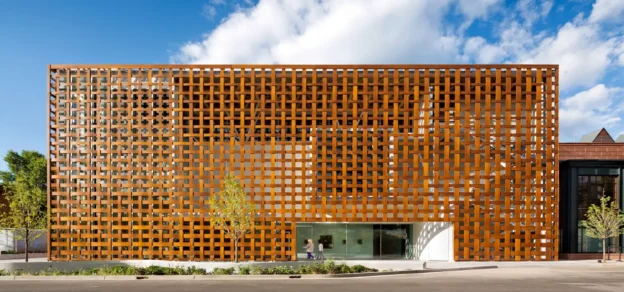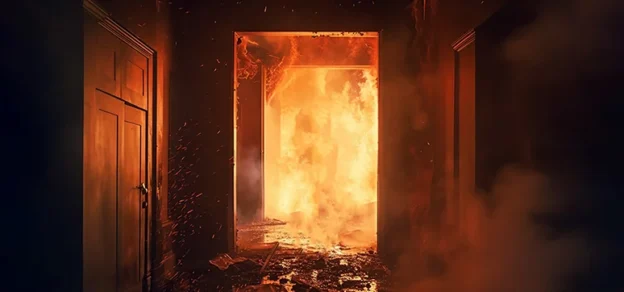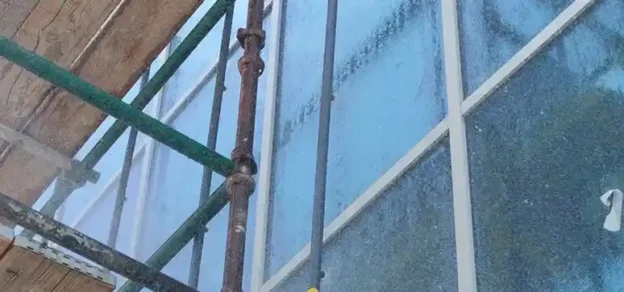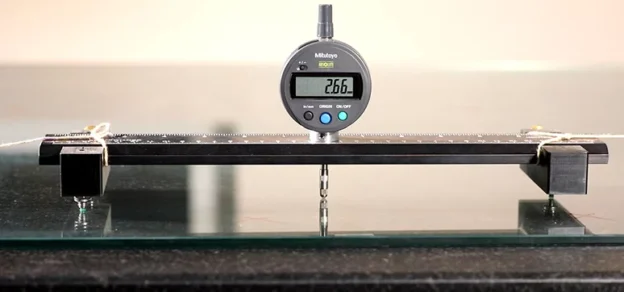If the façade system is not airtight, several damages and issues can occur once the resident starts to stay in the building. Following are the potential consequences of a non-airtight façade assembly. Energy loss is one of the major problems that a resident will face if there is excessive air leakage. Air leaks through the façade can lead to significant energy loss by allowing conditioned air to escape as well as the outside air to infiltrate into the building. This can increase heating and cooling demands, resulting in higher energy consumption. This is not only increasing utility costs but also damaging our environmental system.
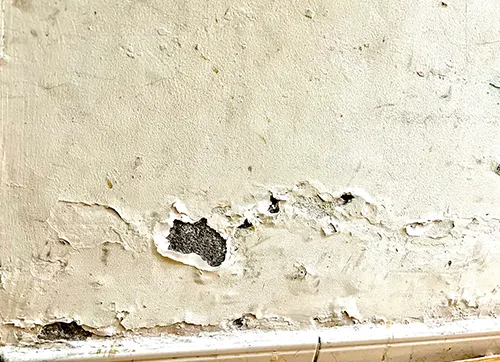
The non-airtight façades system may require more frequent maintenance as well as repairs to address issues such as water damage, mould remediation, degraded building materials, etc. This can result in additional costs and inconvenience for building owners and occupants. This will also reduce the lifespan of building components. Uncontrolled air infiltration can accelerate the deterioration of building materials due to moisture exposure, leading to premature ageing and decreased durability of the façade components.
Excessive air leakage will create moisture infiltration. The Non-airtight façades can allow the entry of moisture-laden outdoor air into the building envelope. This moisture infiltration can result in condensation on all interior surfaces, leading to mould growth, deterioration of building materials, and potential damage to finishes, furniture, and equipment. Prolonged moisture exposure can compromise the structural integrity of the building components. This will also create severe health issues such as respiratory issues, allergies, and other health concerns for occupants. Please note that air leaks can introduce outdoor pollutants, dust, and allergens into the building, negatively affecting indoor air quality.
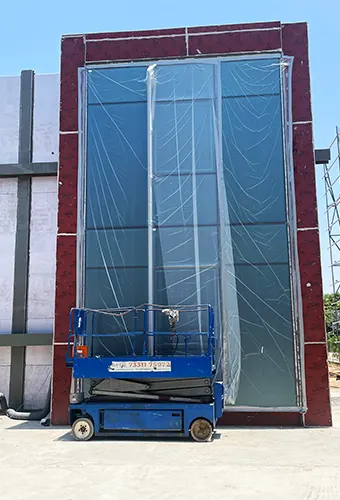
Air leaks in the façade can allow the transmission of external noise into the building, reducing acoustic comfort. This can disrupt concentration, hinder productivity, and create an unpleasant environment for occupants.
How to make sure the building is airtight?
Proper Design is required. Careful attention should be given to the selection of appropriate building materials and construction techniques to minimise air leakage pathways. It is crucial to design and construct façades with airtightness in mind. Proper sealing of joints, windows, and other openings, etc., along with the use of appropriate air barriers and insulation. Once the system is designed, this has to be tested for air leakage testing along with other necessary tests such as water penetration, structural stability, building movement, etc.
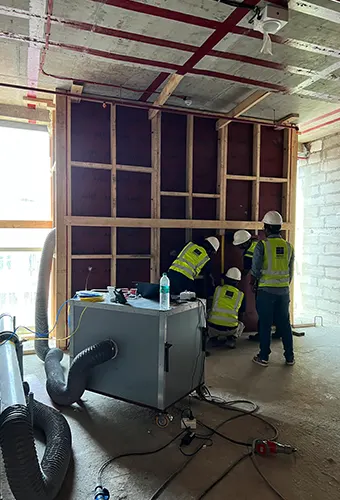
High-quality materials and their construction are to be properly monitored. Ensuring the construction is carried out meticulously and according to best practices can significantly reduce the likelihood of air leaks. Proper air barrier systems play a major role in façade design in terms of air leakage. Installing continuous air barrier systems, such as membranes, sealants, taping, etc. at critical locations can help prevent air infiltration and ex-filtration.
Regular inspections and maintenance are also important to identify and address any potential air leakage issues. ASTM E283 is one of the most common standards being used for determining Air leakage tests. The standard test method was developed by the American Society for Testing and Materials (ASTM) to determine the rate of air leakage through exterior windows, curtain walls, and doors under specified pressure differences across the specimen. This test is commonly known as the “Standard Test Method for Determining Rate of Air Leakage Through Exterior Windows, Curtain Walls, and Doors Under Specified Pressure Differences Across the Specimen.”
The purpose of ASTM E283 is to assess the airtightness of building components, specifically fenestration products such as windows, doors, and curtain walls. The test helps determine the air infiltration and exfiltration rates, which are essential for evaluating the energy efficiency and overall performance of these building elements.
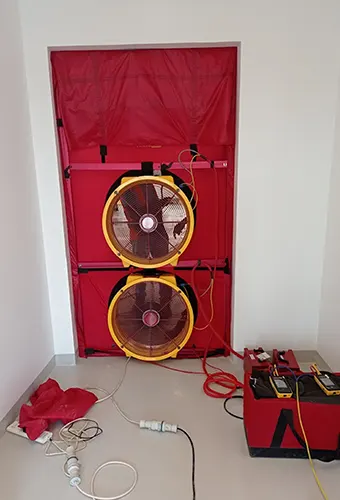
During the ASTM E283 test, the specimen such as façade, doors windows etc. is subjected to various pressure differences across its exterior surfaces, simulating the conditions it may encounter in real-world scenarios. The pressure differences are typically induced by a fan system, and the airflow rate is measured with a calibrated device under controlled conditions. An airtight test chamber is required to perform an air infiltration test as per ASTM E283. The test specimen, which is a specific window, door, or curtain wall assembly, is installed on the same.
The differential pressure measuring device will be used to measure the range of pressure differences between the interior and exterior sides. These pressure differences simulate the wind loads that the building components would experience during normal use. An Air Flow Measurement system and a calibrated fan system are used to create the pressure differences, and airflow is measured across the specimen at different pressure levels.
The rate of air leakage (in cubic feet per minute or cubic meters per hour) is recorded at each pressure level, and this data is used to calculate the air infiltration and exfiltration rates. The results obtained from the test can be compared to building codes, standards, or project specification requirements to assess if the fenestration product meets the airtightness criteria.
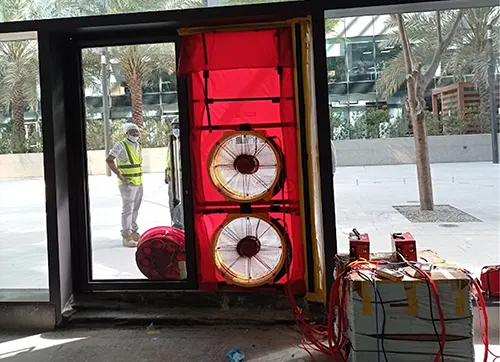
ASTM E283 provides a standardised method for evaluating the airtightness of fenestration products, helping architects, engineers, and manufacturers ensure that these building components meet industry performance standards, enhance energy efficiency, and contribute to a comfortable and sustainable built environment.
ASTM E783, CWCT, BS EN 1026, BS EN 12153, AS/NZS 4284, etc. are similar standards for determining air leakage through façade, doors, and windows being used in the industry. Test procedures and classification or criteria are different in each standard. The test standards are normally specified in the project specifications.
The above-mentioned test standards are specifically applicable to façade system testing. The building can be leaked from other elements as well such as leakage through the electrical conduit, improper sealing of risers, leakage of the HVAC system, etc. An airtightness test can be conducted to measure this leakage as well.
The common airtightness test standards are BS EN ISO 9972, ATTMA TSL1 & TSL2, etc. The purpose of this test is to assess the amount of uncontrolled air leakage through the building envelope, including walls, windows, doors, and other openings. The airtightness of a building is an important factor in determining its energy efficiency, as air leakage can result in heat loss and higher energy consumption for heating and cooling which is mentioned above.
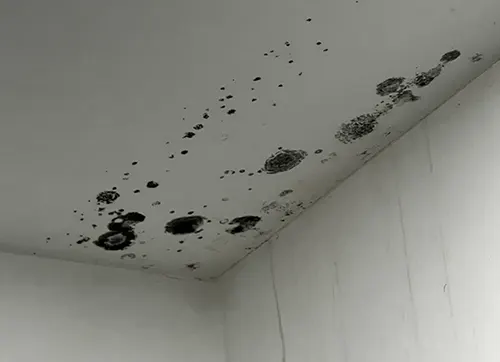
During air tightness testing, the building to be tested should be sealed and unoccupied during the test. All external doors and windows should be closed, and any openings, such as vents, should be temporarily sealed to ensure accurate measurements. The test will be conducted by a blower door system, which includes a calibrated fan that is installed in an exterior door or opening of the building. The fan is used to pressurise or depressurise the building, and pressure sensors are used to measure the pressure difference between the inside and outside of the building.
The blower door fan is set up and installed in an exterior door or opening. The fan is then used to create a pressure difference between the inside and outside of the building. The pressure difference is typically measured at 50 Pascals (Pa), which is approximately the pressure difference that occurs under normal wind conditions. Results and Compliance: The results of the airtightness test can be used to determine the building’s compliance with airtightness requirements specified in national or regional building codes or standards. In some cases, the test results may also be used for energy performance certifications or to identify areas for improvement in the building envelope.
It is important to note that specific details of the test procedure may vary depending on local regulations and practices, but BS EN ISO 9972 and ATTMA TSL standards provide a standardised method for conducting airtightness tests in buildings. The test is typically carried out by trained and certified professionals to ensure accuracy and consistency in the results.


